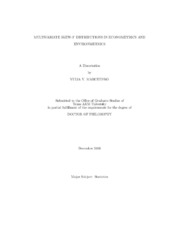| dc.description.abstract | This dissertation is composed of three articles describing novel approaches for
analysis and modeling using multivariate skew-normal and skew-t distributions in
econometrics and environmetrics.
In the first article we introduce the Heckman selection-t model. Sample selection
arises often as a result of the partial observability of the outcome of interest in
a study. In the presence of sample selection, the observed data do not represent a
random sample from the population, even after controlling for explanatory variables.
Heckman introduced a sample-selection model to analyze such data and proposed a
full maximum likelihood estimation method under the assumption of normality. The
method was criticized in the literature because of its sensitivity to the normality assumption.
In practice, data, such as income or expenditure data, often violate the
normality assumption because of heavier tails. We first establish a new link between
sample-selection models and recently studied families of extended skew-elliptical distributions.
This then allows us to introduce a selection-t model, which models the
error distribution using a Student’s t distribution. We study its properties and investigate
the finite-sample performance of the maximum likelihood estimators for
this model. We compare the performance of the selection-t model to the Heckman
selection model and apply it to analyze ambulatory expenditures.
In the second article we introduce a family of multivariate log-skew-elliptical distributions,
extending the list of multivariate distributions with positive support. We
investigate their probabilistic properties such as stochastic representations, marginal
and conditional distributions, and existence of moments, as well as inferential properties.
We demonstrate, for example, that as for the log-t distribution, the positive
moments of the log-skew-t distribution do not exist. Our emphasis is on two special
cases, the log-skew-normal and log-skew-t distributions, which we use to analyze U.S.
precipitation data.
Many commonly used statistical methods assume that data are normally distributed.
This assumption is often violated in practice which prompted the development
of more flexible distributions. In the third article we describe two such multivariate
distributions, the skew-normal and the skew-t, and present commands for
fitting univariate and multivariate skew-normal and skew-t regressions in the statistical
software package Stata. | en |


